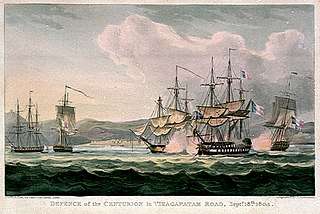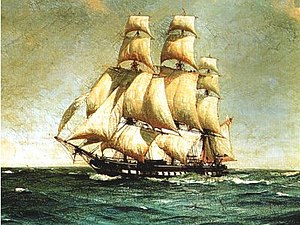
The Sémillante was a 32-gun frigate of the French Navy and the lead ship of her class. She was involved in a number of multi-vessel actions against the Royal Navy, particularly in the Indian Ocean. She captured a number of East Indiamen before she became so damaged that the French disarmed her and turned her into a merchant vessel. The British captured her and broke her up in 1809.
Sardine was a corvette of the French Navy, launched in 1771. The Royal Navy captured her at the Siege of Toulon but the French retook her when the Anglo-Spanish force retreated. The Royal Navy captured her again in 1796. She then served as HMS Sardine until the Royal Navy sold her in 1806.

Berceau was a 22-gun corvette of the French Navy, built to a design by Jacques-Noël Sané, and launched in 1794. The Americans captured her in 1800 but restored her to France the next year. She then served in the Indian Ocean before returning to Spain, where she was broken up in 1804.

Sylphe was an Abeille-class 16-gun brig-corvette of the French Navy. The class was built to a design by François Pestel. The British captured her in 1807 and took her into the Royal Navy as HMS Seagull, but apparently never used her in any capacity. She was sold in 1814.

HMS Alacrity was a Cruizer-class brig-sloop built by William Rowe at Newcastle and launched in 1806. She served in the Baltic and was at the capture of Copenhagen in 1807. She captured a large privateer before herself falling victim to a French man-of-war in 1811 in an action in which her captain failed to distinguish himself. She then served in the French navy until she was broken up in 1822.
The French brig Albanaise was launched in 1790. In June 1800, the Royal Navy captured her in the Mediterranean and took her into service as HMS Albanaise. In November 1800, her crew mutinied, took command of the vessel, and sailed her to Malaga where they surrendered her to the Spanish. The Spanish later returned her to the French, who did not return her to service.
Marsouin was a gabarre, the name-ship of her three-vessel class, built to a design by Raymond-Antoine Haran, and launched in 1787 or 1788 at Bayonne. She carried troops, supplies, invalids, etc., across the Atlantic to the Caribbean or back until the British captured her in 1795. Though the Royal Navy nominally took her into service, she was never actually commissioned, and she disappeared from the lists in 1799.
Two vessels of the Royal Navy have borne the name HMS Fleche, after the French for "arrow":
Perdrix was a corvette of the French Royal Navy, launched in 1784. The British captured her off Antigua in 1795 and she served briefly in the Royal Navy in the West Indies, where she captured a French privateer, before being broken up in 1798.
Flèche was a French corvette built by Louis-Hilarion Chapelle (cadet) and launched at Toulon, France in 1768. The British captured her at the Fall of Bastia in May 1794 and commissioned her into the Royal Navy under her existing name. She observed the naval Battle of Hyères Islands, but then was wrecked in 1795.
Créole was a 40-gun frigate of the French Navy, a one-off design by Jacques-Augustin Lamothe. The French Navy loaned her to a privateer in 1797. Later, she served in the Brest squadron, took part in Ganteaume's expeditions of 1801 to Egypt, and was involved in the French acquisition of Santo Domingo and briefly detained Toussaint Louverture before he was brought to France. The 74-gun ships HMS Vanguard and HMS Cumberland captured her Santo Domingo on 30 June 1803. The Royal Navy took her into service but she foundered soon afterwards during an attempt to sail to Britain; her crew were rescued.
Poulette was a French Coquette-class corvette built to a design by Joseph-Marie-Blaise Coulomb and launched in March 1781. She served the French navy until 1793 when the British captured her at Toulon in 1793. She served briefly in the Royal Navy, including at the battle of Genoa in 1795, until she was burned in October 1796 to prevent her falling into French hands.

HMS Proserpine was a 32-gun Amphion-class frigate built for the Royal Navy during the Napoleonic Wars. The French Navy captured her off Toulon about a year after her commissioning and took her into service as Proserpine. She served in various capacities such as a frigate, troopship, hospital ship, and prison hulk until 1865.

Mohawk was a ship launched at Beverly, Massachusetts in 1781. She became a privateer, making two voyages. In 1782 the Royal Navy captured her and briefly took her into service under her existing name before selling her in 1783. She then became a merchantman until some investors in Bristol bought her in 1796 and turned her into a privateer again. In 1799 she became a letter of marque, but the French Navy captured her in 1801. She then served in the French Navy, capturing a British privateer in 1805, and was sold in 1814.
The French brig Pandour was a brig of the French Navy launched in 1804 that the Royal Navy captured in 1806. In 1807 she became a whaler in the South Seas Fisheries, but was lost in late 1809.

HMS Alert was launched in 1793 for the Royal Navy. In May 1794 the French Navy captured her and took her into service as Alerte. A few months later the Royal Navy destroyed her.

HMS Barbuda was commissioned into the Royal Navy in 1780 after having briefly served as an American privateer. Barbuda was one of the two sloops that captured Demerara and Essequibo in 1781, but the French Navy captured her there in 1782 and took her into service as Barboude. The French Navy sold her to private owners in 1786, and she served briefly as a privateer in early 1793 before the French Navy purchased her again and named her Légère. She served them until mid-1796 when the Royal Navy captured her and took her into service as HMS Legere. She was wrecked off the coast of Colombia, without loss of life, in February 1801.
Belliquese was a French Navy 12-gun brig launched in 1793 as the name-vessel of her class, and sold in 1797 to serve as a privateer. The British Royal Navy captured her in 1798. Though the Royal Navy named her HMS Bellete and took her measurements, it never actually commissioned her; she was sold in 1801.
Entreprenant was the first of a sequence of three vessels of the French Navy in 1807-1810 under the same name and with the same captain. She was a patamar launched in 1807 at Île de France. She cruised in Indian waters against British shipping. Her captain in 1808 turned her over to her prisoners from a capture. After he left, one set of prisoners captured her from another and she then disappears from further records.
HMS Amethyst was launched in 1790 as the French frigate Perle. The British Royal Navy took possession of her at Toulon in 1793. She was wrecked in 1795 at Alderney.









